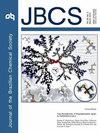用高效液相色谱-紫外分光光度法评价非洲和欧洲蜂王在正常条件下和潜逃过程中产生的下颌信息素
IF 1.3
4区 化学
Q3 CHEMISTRY, MULTIDISCIPLINARY
引用次数: 0
摘要
信息素对蜜蜂的群体组织是必不可少的。信息素9-ODA ((E)-9-氧deco -2-烯酸)和9-HDA ((E)-9-羟基deco -2-烯酸)由蜂后的下颌腺分泌,在蜂群内具有多种功能,包括抑制工蜂卵巢发育、吸引蜂群和稳定集群群。蜂群对不利条件的反应的一个例子是潜逃,潜逃被定义为所有成年个体集体离开,甚至留下后代和食物。本研究采用液相色谱-紫外检测法测定了未交配、正常交配、产卵的欧洲和非洲化蜂王以及潜逃种群的交配蜂王的信息素9-ODA和9-HDA。将自由飞行的五标准朗斯特罗思框架菌落置于人工加热至45℃的室内,诱导其潜逃。结果表明,与欧洲蜂王相比,非洲化蜂王的9-ODA含量(6.56µg bee-1)非常低。然而,在潜逃的非洲化蜂群的蜂王中发现了大量的9-HDA(107.4µg bee-1)。研究结果表明,巴西非洲化蜜蜂中9-ODA和9-HDA的数量可能是导致其潜逃率高,稳定剂效果低,分散剂群吸引效果高的原因。本文章由计算机程序翻译,如有差异,请以英文原文为准。
Evaluation of the Mandibular Pheromones Produced by Queens of Africanized and European Honeybees under Normal Conditions and During Absconding Processes by HPLC-UV Methodology
Pheromones are essential for colony organization in honeybees. The pheromones 9-ODA ((E)-9-oxodec-2-enoic acid) and 9-HDA ((E)-9-hydroxydec-2-enoic acid), produced by the mandibular gland of the queen, have various functions within the colony, including inhibition of ovarian development of workers, attraction of swarms, and stabilization of the cluster group. An example of reaction of the colony to adverse conditions is absconding, which is defined as mass exit of all of the adult individuals, leaving even brood and food. In this study, the pheromones 9-ODA and 9-HDA were determined in virgin and normal mated, egg-laying European Carniolan and Africanized queens, as well as in mated queens that were in absconding colonies, using liquid chromatography with UV detection developed methodology. Absconding was induced by maintaining free-flying five-standard-Langstroth-frame colonies in a chamber artificially heated to 45 ºC. The obtained results showed that the amount of 9-ODA in Africanized queens (6.56 µg bee-1 ) is very low compared with European queens. However, large amounts of 9-HDA were found in the queens of absconding Africanized swarms (107.4 µg bee-1). According to our results, the quantities of 9-ODA and 9-HDA in Africanized honeybees in Brazil may be contributing to the high rates of absconding, promoting low effect of stabilizing agent, and high effect of attraction of dispersers cluster.
求助全文
通过发布文献求助,成功后即可免费获取论文全文。
去求助
来源期刊
CiteScore
2.90
自引率
7.10%
发文量
99
审稿时长
3.4 months
期刊介绍:
The Journal of the Brazilian Chemical Society embraces all aspects of chemistry except education, philosophy and history of chemistry. It is a medium for reporting selected original and significant contributions to new chemical knowledge.

 求助内容:
求助内容: 应助结果提醒方式:
应助结果提醒方式:


